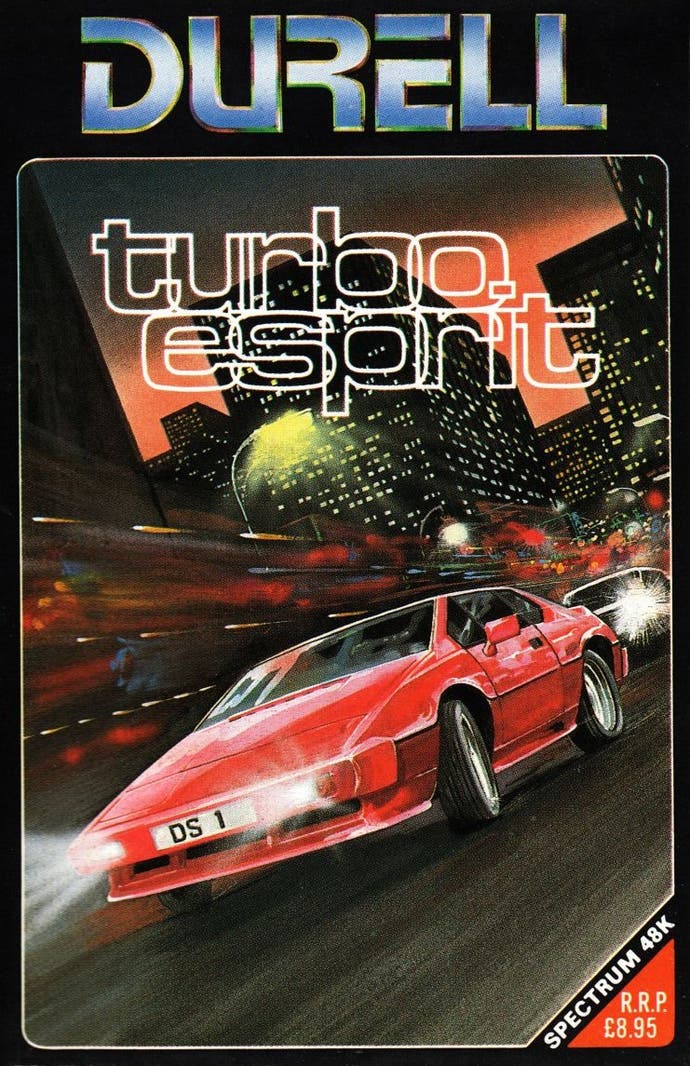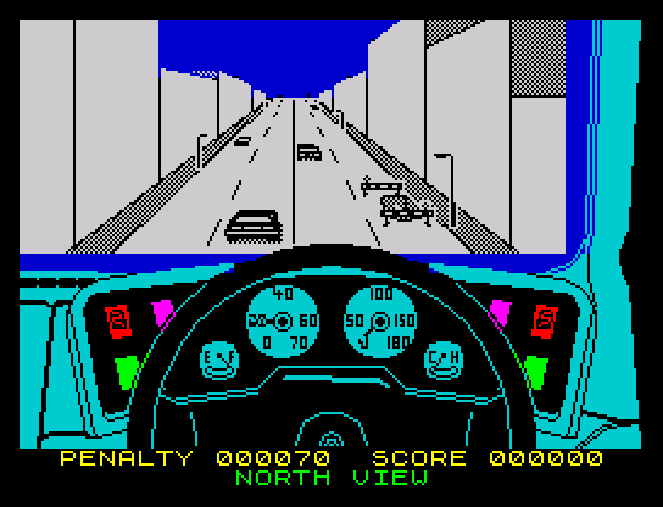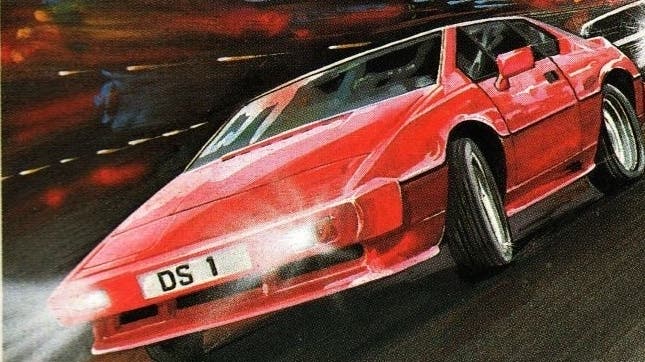The making of Turbo Esprit, the Spectrum game set in Romford that predated GTA
Lotus blossom.
Rockstar's Grand Theft Auto has become such a behemoth it seems strange the series started out life as an unexpected smash. Driving around the cities in that first top-down crime caper was thrilling and liberating; there was no being forced down dingy first-person corridors here, and you could gleefully ignore the game's missions and enjoy exploring/causing mayhem in the sprawling urban environment. GTA was often cited as refreshingly original in the games press of the time - yet those of us who had been playing on our ZX Spectrums eleven years earlier thought it all played a little familiar to a multi-city adventure by the name of Turbo Esprit.
But the miracle of Turbo Esprit is not just its innovative gameplay, but the way it presents a real and suitably grim 80s urban landscape for the player to drive around, all within a mere 48k of memory. Traffic lights operate with annoying frequency, pedestrians stroll around, seemingly oblivious to the speeding cars that charge down the narrow streets and stark, angular buildings enshroud every screen. The player, assuming control of the eponymous sports car, can either take on the nefarious drug dealers or buzz around the city, obeying - or disobeying - the Highway Code to their heart's content. Sound familiar?

The freedom to make this choice was rarely seen in 1986. "I wanted a game where you could drive around a city in real time, with the fantasy of James Bond-like machine guns to blow away the bad guys," says Robert White, owner and founder of Turbo Esprit's publisher, Durell Software. "So I took the parallelepiped concept from BDS to make skyscrapers in a way that a whole city block could rapidly be drawn from a surprisingly compact database." With his experience as a CAD specialist for the Oxford Regional Health Authority, which used an integrated computer modelling system (the aforementioned BDS) to design its hospitals, White fostered the concept of an urban landscape, with the player free to move around within its confines.
When he started Durell, White originally saw himself as the company's main programmer until the realities of running a business in a booming industry hit home. "I recruited Mike Richardson and Ron Jeffs to do the legwork - Mike already had a game, Jungle Trouble, although to start off we concentrated on Harrier Attack." With Richardson and Jeffs producing brilliant versions of the shoot-'em-up on the ZX Spectrum and Oric respectively, Durell was quickly established as a serious player. "Computer games were new at the time, although I had recognised certain types had already evolved," notes White. "I consciously wanted to break away from the clunky Space Invaders and platform [style] of Manic Miner." With Harrier Attack, Jungle Trouble and Scuba Dive already done, programmer Mike Richardson had broken new ground with an ambitious helicopter simulation. "I had just finished Combat Lynx," recalls Richardson, "which is a free-roaming 3D game, so I don't think the sandbox aspect especially felt novel. However, when considering [Turbo Esprit] as a whole, it did register with me as being a bit of a first."
In Turbo Esprit, the player takes on the role of a special agent, ensconced within the James Bond-esque sports car. An international ring of drug dealers are about to drop a huge shipment of heroin, and it's up to you to stop them. Cars laden with drugs cruise around, homing in on the armoured van which is used for transportation out of the city. Upon loading the game up, there's a choice of four different cities to choose from: Wellington, Gamesborough, Minster and, err, Romford. "I called one Wellington, because that's where I live in Somerset," explains Richardson. "I was a bit stuck after that - Gamesborough was because it had the word 'game' in it and Romford because it has the acronym ROM. But Minster? I have no idea!" However, because of the limitation of the way the maps were compactly stored, designing anything based on real towns was an impossibility, so anyone hoping to spot their street in suburban Romford is going to be disappointed.

With the idea established, Richardson got to work. Self-employed, yet working exclusively for Durell, the three men initially sat together in one room, before the string of gaming hits necessitated a move to bigger premises. "At the start of the project I bought an Epson CP/M machine - it cost an absolute fortune!" continues Richardson. "It had two 5.25 inch floppy drives and 256k of RAM, I used Microsoft's MASM assembler and a bit of code to download to the Spectrum via a printer port." Despite his experience, Turbo Esprit was no ordinary project to bring to life. "There was no internet back then, and technical programming and math information was scarce and difficult for me to find. I live in the West Country, so the local library was never much help - most of the books were about tractors and cows."
Taking the base of the fundamental drawing techniques used in Combat Lynx, the coder worked on adapting it into a combat-driving game. "Technically the 3D is based on a look-up table indexed by a stepped distance from the viewpoint. This table contains constants, mostly for 3D to screen co-ordinate conversion - these I guessed at, and modified until the scene looked right." With the background and internal car graphics achieved through simple line drawings and fill routines, each city map is stored as a grid of junctions, the rows and columns specifying how many lanes the road has, whether it is one-way and extra items such as traffic lights and garages. Yes, in Turbo Esprit, you even had to remember to fill up, and the scale and method resulted in a huge amount of memory usage, straining the Spectrum to its limits. Explains Richardson, "Data for the four city maps was stored in the memory used for the internal buffer when loaded. Once the player had picked the city, the other three are discarded so the memory becomes available." The result was having to reload the game should you wish to try another city.

If you are lucky enough to have seen the inside of a Lotus Esprit vehicle circa 1985, it would be clear that the interior present in Durell's game is admirably faithful, and the game's adverts boasted of 'technical assistance' from the car's makers. "To be honest it's all pretty hazy now," says White, "but we certainly didn't have a licence and we didn't get any technical support." What did definitely happen was a factory visit and test drive early on in Turbo Esprit's development. "They probably told us we could do anything that might promote them, but the 'technical assistance' claim was hokum I'm afraid - we didn't have any financial dealings with them." Having gone on a similar jaunt to Westland Helicopters during the development of Combat Lynx, Richardson remembers coming away from Lotus with nothing more than a selection of marketing materials which he used to fashion the game's accurate dashboard.
Core gameplay aside, it's the unprecedented level of detail in Turbo Esprit that most impresses. Indicators, pedestrians, window cleaners and traffic, all operating around and independently of the player - just like in the famous Rockstar series. "I believe I largely made them up as I was going along," admits Richardson. "Really, I just did the obvious nice to-do things. The game itself can give players a purpose - if they want or need one." After ten months of work, Turbo Esprit was nearing completion, with Richardson having successfully wrestled the technical challenges, the biggest of which was vehicle AI. "It was aided by having an internal model of what is on screen, consisting of a 2D map of the junction ahead. As the player drives through a junction, a new model is created of the next junction with the existing road then copied to behind." The AI vehicles, rather than wandering around the whole city - far too much effort for the Speccy - existed only within this internal model. Other concepts such as a rear-view mirror and first-person view were jettisoned as Richardson tinkered around with what worked, and what could be achieved satisfactorily within the confines of the Sinclair computer.
By 1986, Turbo Esprit was ready, at least on the home ZX Spectrum version. Critically acclaimed upon release, reviewers appreciated the technical achievement, welded to an unusual gameplay. Sales, as a solo release, and part of a four-game compilation were solid, and a decent Amstrad CPC conversion appeared shortly afterwards. Sadly, on the Commodore 64 computer, things fell apart dramatically, and the game was deemed unworthy of release, save as a part of the aforementioned compilation and a subsequent £2.99 budget release, both of which were vilified. Yet despite the success on the Spectrum, Robert White wasn't particularly compelled to even consider a sequel.

"It never crossed my mind," he says. "More of the same is a bit boring, isn't it?" Richardson, keen to develop fresh concepts for each new game, doesn't recall the idea of Turbo Esprit 2 even being discussed. "If it had been, then I would probably have shied away from it - I preferred to do different things and was actively opposed to sequels." Given that in his next game for Durell, Richardson had the player taking on the role of a giant rampaging dragon, laying waste to a fantastical medieval world, he certainly remained true to his word.
Looking back today, it's easy to trace a line that slices through Turbo Esprit and continues on through Grand Theft Auto and beyond - if nothing else, for the idea of freely driving a vehicle around an open city, engaging in the game's plot and missions as you see fit. "I think it's probably a forebear, in much the same way that Harrier Attack followed the Defender scrolling type of game," notes White, who has ceded control of Durell to his son these days, the company now specialising in insurance software. While it's unclear whether GTA would have existed without Turbo Esprit - the designers have been quoted as having said they were unaware of the Spectrum game - that line clearly exists nonetheless. "I think it's an evolutionary process, like the design of aircraft," continues White, "and Turbo Esprit in turn probably owes a vote of thanks to BDS."
For Turbo Esprit's sole programmer, the talented Mike Richardson, it remains his favourite of a very impressive roster of games. "It was the most technical game that I wrote during the Spectrum days, and was really technically the pinnacle of them all with things that I hadn't done before such as sprite masking, compact sprite mask storage, area fill and the internal map model in memory. But I'm very proud of all the Spectrum games I wrote. I really miss those times."
My thanks to Robert White and Mike Richardson for their time.








.png?width=291&height=164&fit=crop&quality=80&format=jpg&auto=webp)
